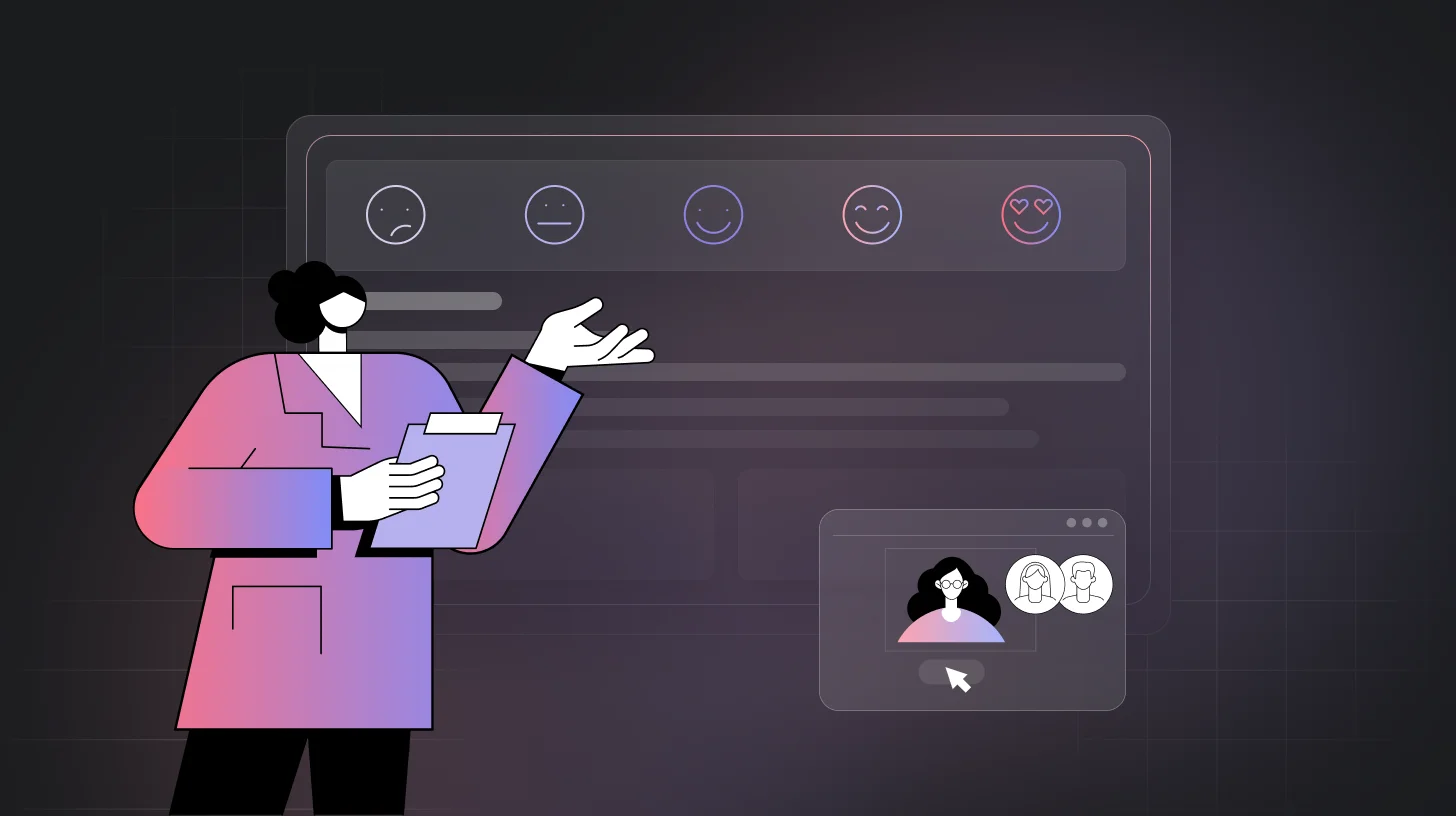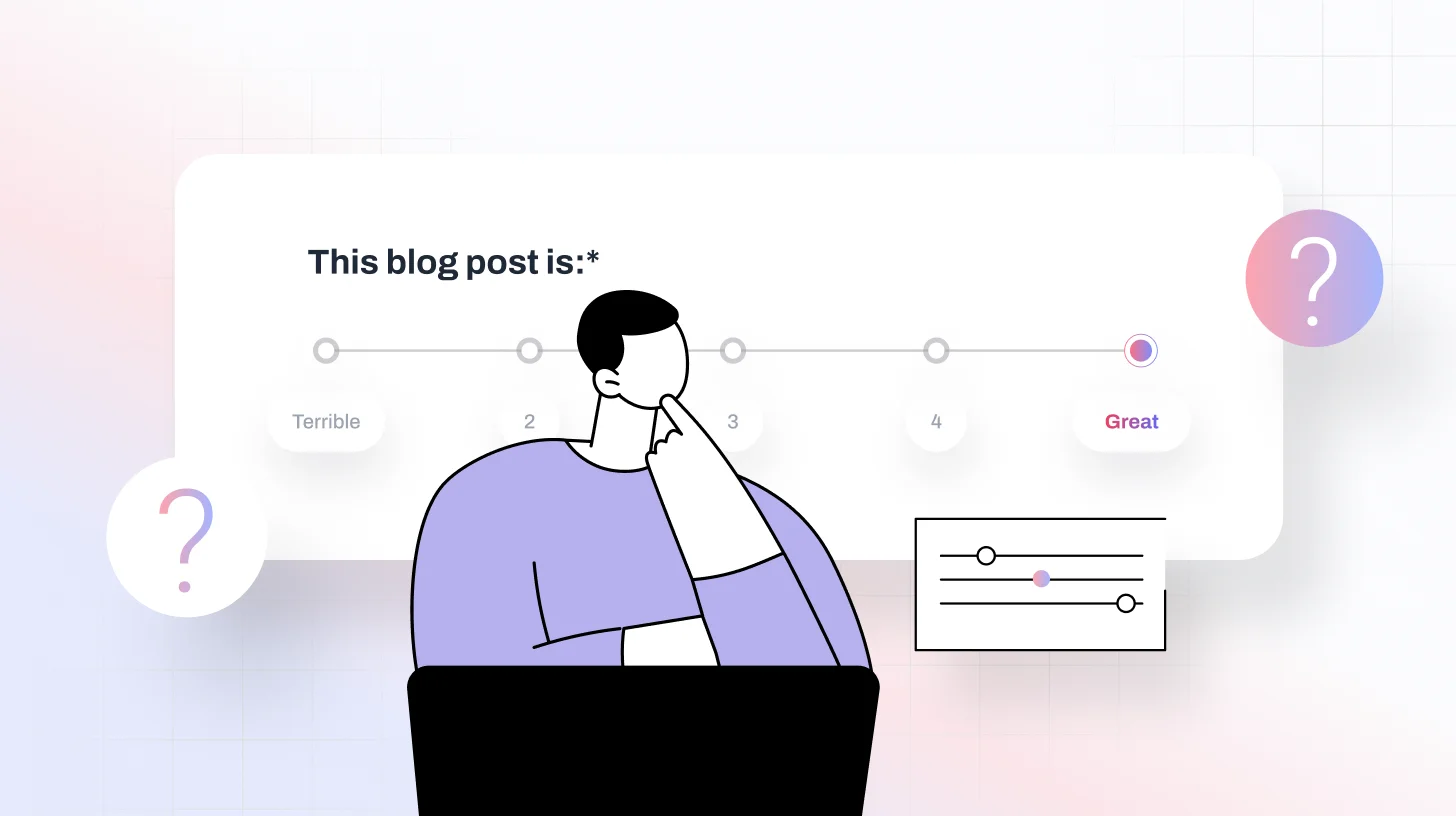 Blog
Blog B2B Customer Satisfaction Survey: Questions, Metrics, and Template
B2B Customer Satisfaction Survey: Questions, Metrics, and TemplateB2B Customer Satisfaction Survey: Questions, Metrics, and Template

Measuring B2B customer satisfaction is a core business strategy. In B2B, you are not just delivering products or services; you are building long-term relationships and high-stakes partnerships that influence revenue, client retention, and long-term growth.
If you're not actively checking in on their satisfaction, you risk losing more than just a deal; you risk losing future revenue, referrals, and your competitive edge.
According to a 2024 study by Bain & Company, 80% of B2B companies believe they deliver great customer experiences, while only 8% of their customers agree. That’s a massive perception gap, and it can result in millions of dollars in lost renewals and churn.
At TheySaid, we believe every piece of customer feedback is a conversation waiting to happen. But in B2B, those conversations don’t always come easily. Multiple stakeholders, long buying cycles, and complex product journeys can cloud the customer experience.
That’s why we created this guide to help B2B teams design smarter surveys, ask the right questions, and turn satisfaction data into decisions.
Let’s get started!
What is a B2B Customer Satisfaction Survey?
A B2B customer satisfaction survey is a structured way of gathering feedback from your business clients. Unlike B2C, which targets individual users, you are targeting multi-stakeholder accounts such as procurement managers, product users, and executive sponsors.
To better understand, let’s imagine a scenario.
You’re a company that manufactures and supplies industrial packaging to large e-commerce and logistics businesses. Your B2B clients rely on your packaging for sending millions of parcels each month.
To ensure satisfaction and strengthen your relationship, you should check in with client stakeholders, including the Procurement Manager, the Warehouse Supervisor, and the Sustainability Lead.
This is what makes B2B customer satisfaction more critical. It’s not about pleasing just one person. It’s about aligning with multiple roles, each with different goals and priorities. A B2B satisfaction survey helps you do exactly that.
Also Read: How to Design B2B Surveys That Capture Real Buyer Insights
How do you measure B2B customer satisfaction?
In B2B, you are managing complex relationships with multiple stakeholders, long contracts, and high-value accounts. To measure it effectively, you need a mix of direct feedback and behavioral metrics.
Here are the key metrics B2B companies use to measure customer satisfaction:
Customer Satisfaction Score (CSAT)
The customer satisfaction score is a commonly used metric that measures how satisfied customers are with your product or service. It’s typically collected right after a key touchpoint, like onboarding, a support call, or a feature release. Responses are usually collected on a 1–5 or 1–10 scale, and averaged to show how well you're doing.
Net Promoter Score (NPS)
In B2B, it's a core customer experience (CX) metric that measures customer satisfaction and loyalty with a fundamental question: How likely are you to recommend us to your friends and family? In B2B, you can collect NPS by role (decision-makers vs. users) for deeper insight.
Clients answer on a scale from 0 to 10. You then segment them into:
- Promoters (9–10): loyal, enthusiastic
- Passives (7–8): neutral
- Detractors (0–6): unhappy or at risk
Your NPS = % Promoters – % Detractors
Also read: 50 Net Promoter Survey Questions to Boost Customer Insights
Customer Effort Score (CES)
The customer effort score is an invaluable metric that reveals how easy or difficult it is for your customers to obtain what they need from your business. In B2B, friction kills adoption. If your platform is technically brilliant but challenging to use, that’s a long-term risk. CES helps you spot and reduce that friction early.
Rated from “Very Difficult” to “Very Easy,” this score tells you how much effort your customers have to put in to get value from your product or service.
Customer Health Score
A customer health score is a metric that combines both qualitative and quantitative signals (e.g., Product usage frequency, Support tickets, Survey scores, Renewal history, Engagement level) into one signal that helps identify which accounts are thriving, at risk, or ready for expansion.
Lifetime Value (CLTV) and Churn Rate
CLTV estimates the total revenue a customer will generate over their lifetime. And Churn Rate measures the percentage of customers who stop doing business with you. Monitoring CLTV and churn helps you understand satisfaction at a financial level.
Want to dig deeper into churn? Check out our blog: Real Reasons for Customer Churn and Fixes.
%20and%20Churn%20Rate.webp)
B2B Customer Satisfaction Survey Questions
In a B2B context, satisfaction isn’t just about a single experience. It reflects how well you’re delivering across multiple areas, like product reliability, account management, responsiveness, and long-term value. These questions provide a well-rounded view of what’s working and what needs improvement.
Demographic Questions
Demographic questions help you understand the characteristics of your audience and segment them by role, department, region, or experience level. In B2B, this might include factors such as industry, company size, job role, and level of decision-making authority.
Examples:
- What is your job title or primary function?
- What industry does your organisation operate in?
- How long has your team been using our product/service?
- Are you a daily user, an occasional user, or a decision maker?
- What is the size of your organization?
Post-Purchase Questions
These questions help you gauge the initial impression of customers with your product or service and how well the early impressions match the reality after the sale.
- How satisfied are you with our purchasing process?
- Did you feel confident using the product by the end of onboarding?
- How would you rate the helpfulness of your onboarding specialist?
- Did the product/service meet your expectations?
- How likely are you to recommend us based on your purchasing experience?
Billing, Invoicing, and Payment Process Feedback Questions
Even if your product is great, poor billing experiences can erode trust and lead to churn. This is especially true in B2B, where finance teams are involved in renewal decisions.
- How satisfied are you with the payment methods and terms provided
- Was our invoicing process clear and easy to understand?
- Have you experienced any billing issues or delays?
- Were your payment processes without any issues?
- Give suggestions on how we could improve our billing and invoicing process
Pricing Feedback Questions
Pricing plays a critical role in a client’s decision to partner with your business. It’s essential that your pricing reflects the value you deliver and remains competitive in the market so customers feel confident that they’re making a worthwhile investment.
- How satisfied are you with the pricing options we provide?
- Do you feel you’re getting good value for the price you pay?
- How clear and fair do you find our pricing structure?
- How would you rate your experience with receiving customized pricing or quotes from our team?
- Have you encountered any challenges or confusion regarding our pricing policies?
Post-Onboarding Questions
Onboarding is a make-or-break moment. These questions identify pain points in training, setup, or first use.
- How would you rate your overall onboarding experience with us?
- Did you encounter any challenges or obstacles during the onboarding phase?
- How would you rate the quality and usefulness of the onboarding resources and materials provided?
- Was our onboarding team responsive, helpful, and easy to work with?
- To what extent did the onboarding process meet your expectations?
Recommended read: How to Conduct an Effective Onboarding Feedback Survey
Product Usage Questions
These questions help identify gaps or pain points in your product experience, enabling your team to make informed improvements and deliver greater value to customers.
- How intuitive do you find our platform?
- Which features do you use the most?
- Have you experienced any bugs, outages, or lags?
- Are there any features you expected but couldn’t find?
- How would you rate the performance of our product on a typical day?
Follow-Up Questions
Follow-up questions help you gather deeper insights after key customer interactions. Whether a customer had a positive or negative experience, these questions show that you’re listening and that you're committed to continuous improvement.
- We’re happy to hear you had a positive experience. What did you find most valuable or helpful?
- What’s one thing we could do to better support your team?
- How likely are you to renew your contract with us?
- We’re sorry your experience didn’t meet expectations. Can you tell us what went wrong so we can improve?
- What could we have done differently to make your experience more successful?
Recommended read: What are Follow-Up Questions in Surveys?
Customer Support Satisfaction Questions
Customer support plays an important part in shaping the overall customer experience. The effectiveness of your support team's response to questions, resolution of issues, and communication with clients can significantly impact customer satisfaction, loyalty, and long-term relationships.
Examples:
- Was your issue resolved to your satisfaction level?
- On a scale of 1 to 10, how would you rate the responsiveness of our team?
- How well did our support team communicate throughout the resolution process?
- Is there anything we could have done better during your support experience?
- Based on your support experience, how likely are you to continue working with us?
Product Innovation & Roadmap Alignment Questions
Your customers want to know you're evolving. Asking them for feedback on the roadmap builds loyalty and surfaces great ideas.
Examples:
- Are we moving in the right direction with our product roadmap?
- What features would you love to see in the next 6–12 months?
- Have we delivered product improvements that matter to you?
- How involved do you feel in shaping our product evolution?
- Would you be open to joining our beta testing group?
Partnership & Strategic Alignment Questions
Because great B2B relationships go beyond the product, they’re built on trust and shared goals. If you’re seen as a strategic partner, you’re far more likely to retain, grow, and expand the business.
Examples:
- Do you view us as a strategic partner or just a service provider?
- How well do we understand your business priorities?
- Are we helping you meet your long-term objectives?
- Would you recommend us to other departments or teams?
- What can we do to better align with your future goals?

Suggested Read: B2B Marketing Survey 2025: Questions, Examples & Strategy Guide
B2B Customer Satisfaction Survey Template
1. How likely are you to recommend our company to a colleague or industry peer?
(0 = Not at all likely, 10 = Extremely likely)
2. Is your current project with us?
- Active
- Completed
3. How would you rate the support from your account manager?
- Extremely helpful
- Very helpful
- Somewhat helpful
- Not very helpful
- Not at all helpful
4. Did we stick to your expected project timeline?
- Yes, exactly
- Mostly
- Somewhat
- Not really
- Not at all
5. How likely are you to work with us again in the future?
- Extremely likely
- Very likely
- Somewhat likely
- Not so likely
- Not at all likely
6. What aspects of our service stood out most to you?
[ Open text box ]
7. What can we improve to better serve you?
[ Open text box ]
8. Would you be open to sharing a testimonial or case study?
- Yes
- Maybe later
- No
Thank you for your feedback!
Your input helps us strengthen our partnership and deliver more value.
Create B2B Customer Satisfaction surveys

Old way: Open a spreadsheet, write 15 questions, chase responses, analyze results manually.
New way: Use TheySaid.
Here’s how it works:
Drop a URL — TheySaid learns your company.
Click once — AI builds your entire survey.
Send it out — Use email, Slack, QR codes, or in-app messages.
Watch AI do its thing — Customers talk with AI and share honest feedback.
Get actions, not just answers — AI summarizes feedback and highlights what to do next.
Launch your AI-driven B2B Customer satisfaction survey with TheySaid now!
Key Takeaways
- Use CSAT, NPS, CES, and Health Scores to measure satisfaction from all angles.
- Segment responses by role (decision-maker, user, finance) to uncover true account-level insights.
- Ask questions across the entire journey: onboarding, billing, usage, support, and beyond.
- Make satisfaction surveys a two-way conversation, not a checkbox task.
- Act on the feedback, don’t just collect it. Customers remember what you do, not what you ask.
- Use AI tools like TheySaid to speed up survey creation, feedback analysis, and action planning.
- Involve multiple stakeholders to avoid blind spots and strengthen long-term relationships.
- Measure financial satisfaction, too; churn and CLTV are just as important as sentiment scores.
Bottom line
B2B customer satisfaction isn’t a single score; it’s a strategic conversation across every touchpoint. If you’re not asking the right people the right questions at the right time, you're leaving money, loyalty, and growth on the table. Use tools like TheySaid to listen smarter, act faster, and turn every insight into impact.
FAQs
What types of questions should I include in a B2B satisfaction survey?
Include a mix of NPS, CSAT, and open-ended questions around product value, support quality, ease of use, communication, onboarding experience, billing, and long-term relationship expectations.
How often should I run B2B satisfaction surveys?
Ideally, run them quarterly or after key milestones (e.g., onboarding, renewal, product release). Don’t wait until churn risk appears—be proactive.
Who should I send B2B surveys to?
Send to a range of contacts: executive sponsors, end users, procurement, IT, and customer success managers—anyone who influences satisfaction or retention.















.svg)